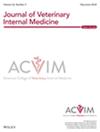Retrospective evaluation of risk factors for worsening renal function after angiotensin-converting enzyme inhibitor treatment in dogs
Abstract
Background
Angiotensin-converting enzyme inhibitors (ACEi) have the potential to cause worsening renal function (WRF). Therefore, reevaluation of renal function is recommended 1-2 weeks after starting ACEi therapy.
Objectives
To identify risk factors for WRF in dogs receiving ACEi for cardiac diseases, proteinuria, or systemic hypertension.
Animals
A total of 156 client-owned dogs that received ACEi were included.
Methods
Serum creatinine concentration was determined at the initial presentation and first reevaluation to detect and grade WRF (increase in sCr ≥ 0.3 mg/dL). Grade 1 (nonazotemic), 2 (mild), and 3 (moderate to severe) WRF were characterized by sCr remaining ≤1.6 mg/dL, 1.7-2.5 mg/dL increase, and 2.6-5.0 mg/dL increase, respectively. Demographic and serum chemistry data, such as total protein, albumin, blood urea nitrogen, creatinine, symmetric dimethylarginine, glucose, triglyceride, total cholesterol concentrations, and serum electrolyte concentrations at first presentation, were evaluated. Multivariable modeling was performed to identify risk factors for WRF after treatment with ACEi.
Results
Worsening renal function was identified in 27/156 (17%, 95% confidence interval [CI], 0.11-0.23) dogs after ACEi treatment. It was classified as Grades 1, 2, and 3 in 17, 2, and 8 dogs, respectively. The only significant factors associated with WRF in dogs receiving ACEi were concurrent administration of furosemide (odds ratio, 5.05; 95% CI, 2.05-12.4; P < .001) and pre-existing azotemia (odds ratio, 3.21; 95% CI, 1.28-8.03; P = .01).
Conclusions and Clinical Importance
Although WRF is uncommon and mild, ACEi should be cautiously prescribed in dogs receiving furosemide or those with pre-existing azotemia.


 求助内容:
求助内容: 应助结果提醒方式:
应助结果提醒方式:


